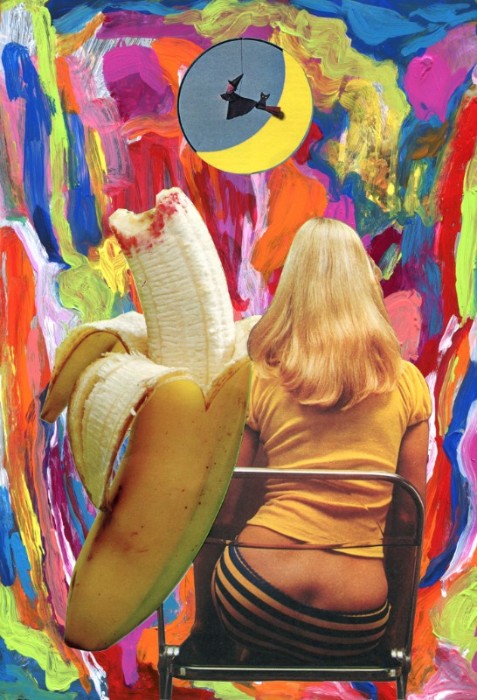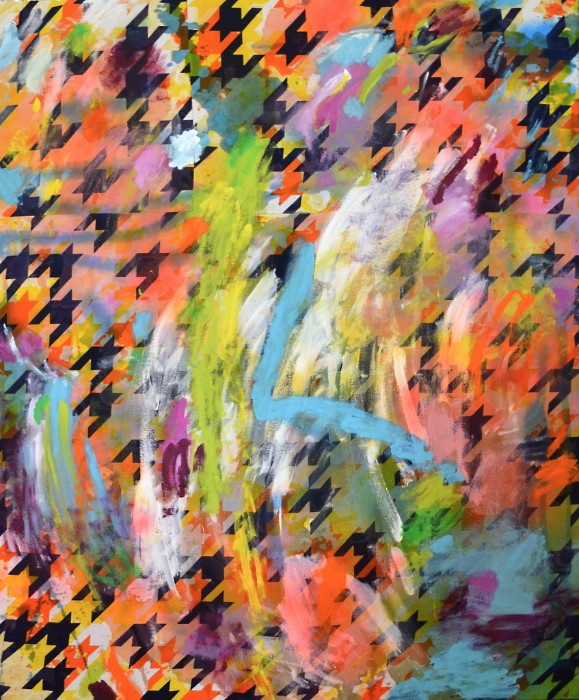Minna Gilligan works primarily in painting, drawing and collage. She completed her two-year Gertrude Studio residency at the end of 2016. Minna has a Bachelor of Fine Arts (First Class Honours) from the Victorian College of the Arts. Minna works as an illustrator for New York-based online magazine ROOKIE and is a member of artist collective The Ardorous, curated by Canadian photographer Petra Collins. She also performs in the band Pamela with Georgina Glanville and Gertrude Alumni Artist Jon Campbell. Minna is represented by Daine Singer, Melbourne.
Minna has published three books,Time After Time, 2015 (Hardie Grant Australia/ Rizzoli New York), Poems, Prayers and Promises, commissioned by the National Gallery of Victoria and So Far, 2016 recently released at the New York Art Book Fair. She sat down with Development and Communications Manager Laura De Neefe, to chat about her varied practice, her time at Gertrude, and what's looming on her horizon.
Laura De Neefe: Although you work across different mediums, you have such a distinctive and recognisable aesthetic. Did developing your own style come quite intuitively? What have been some of your influences in building this aesthetic?
Minna Gilligan: My own aesthetic definitely came intuitively, however its direction was reliant on outside stimulus that I subconsciously soaked up like crazy at the time. I was well into second year at VCA and was expanding my mind in ways only a space like art school could facilitate. I didn’t socialise a whole lot, and subsequently spent heaps of time on Tumblr and Instagram and would watch films and read books I’d borrow from the library having these kind of epiphany experiences visually and melodically every second of the day. It was definitely this type of renaissance period I went through that forged the path for the work I respond to and the work I make now. I don’t think that’s an individual experience somewhat, but it’s individual in what results, in the curated sparks you inexplicably extract from the mess and subsequently interpret.
LDN: In the recent exhibition Dancing Umbrellas at Heide Museum of Modern Art, you presented a series of GIFs. What drew you to incorporate this particular form of digital media on your practice?
MG: I made gifs a whole lot for my blog and social media accounts a few years ago, initially as a somewhat creative/three dimensional documentation of my outfits at the time. They became like this open-ended narrative that I was the protagonist in, they facilitated a character and a scene in the way I felt a collage did. Sue Cramer, the curater at Heide, trawled back through my blog and found these gifs I’d made and asked if I’d consider showing them. As I’m pretty into legitimising internet art and the ‘selfie’ I was really into the idea. We built this wall at Heide so that the gif works could sit flush and on exactly the same plain as the collages and they both became these sort of infinite windows or portals – hence the title of the work ‘Song outside my window’. I made some new gifs to sit alongside the old gifs and there was like me at 19 alongside me now. I enjoyed approaching the process again in a more ‘serious’ manor, but I think the newer gifs still emanate that slightly self-conscious softness and youth of the originals.
LDN: Your collage works often include vintage images, especially of women and domestic spaces from the 1960s and 1970s. How do you choose these images to collage? Is this time period and domestic aesthetic an important touchstone for you?
MG: I have a scary amount of books that then contain an even scarier amount of imagery. The way I choose what to use and what not to use is often, at times hard to put into so many words. In a particularly potent crit in VCA honours, someone described the way I navigate amongst the imagery to be like a medium – as if something else from somewhere else is communicating to me inexplicably what to cut out and what to leave. I related to that in a lot of ways, because a lot of the time my choices are based on an intuition of knowing of what’s wrong or right for a work simply because I just know. The women I choose are characters in my narratives, they are either right or wrong and there’s no in-between. It’s very easy for me to make decisions when it comes to collage imagery. Women are my favourite protagonists, as I want women and women identifying people to take up space and be visible in ways that make them powerful. It sounds super simple but as a feminist that’s always been my main objective, I just never saw it potentially being any other way.
In regards to domestic spaces — I’m attracted to how absent and stilted they can be in books, and how I can then occupy them in whatever way I choose. The 1960s and 1970s had this absolutely dynamic energy that filtered down into curtains and bedspreads and carpets from psychedelic drug culture. I love how everything seemed completely saturated, completely soaked in this fearlessness. The spaces embody that for me, and I can inhabit the emptiness of these interior shoots with whomever and whatever I want.
I wrote my whole honours thesis on why I have this captivation with the time periods of the 1960s and 1970s and I never really figured it out completely. It’s all the above stuff I suppose, coupled with a misplaced nostalgia handed down to me from my Mother who raised me exclusively on music and fashion of those eras…
LDN: You are coming to the end of your two-year studio residency at Gertrude Contemporary. Can you tell us how having a studio at Gertrude has shaped or perhaps changed your practice and output?
MG: Having a studio at Gertrude has been monumental in helping me to personally legitimize my practice. The supportive community and staff at Gertrude have been vital forces in allowing me to figure out where I think my work sits in a contemporary context, as I’ve struggled with labels being thrust upon me, and with working between fine art and commercial practices. It meant a lot for me to be accepted into this institution as an equal, as someone with something important to say - and reminds me that perspectives are changing and people are becoming less reluctant to pigeon hole people and their practices. Not to mention that this will no doubt be the most glamorous studio I will ever inhabit in my lifetime!
LDN: What are you working on at the moment?
MG: I just released my third book, which just launched last week at the New York Art Book Fair. It’s called ‘So Far’, and is a collection of my collage works “so far…”
In January I am having a solo exhibition at Castlemaine Art Gallery, and I’m also currently making work for the end of year Gertrude exhibition.
LDN: What are you reading at the moment?
MG: Tavi Gevinson’s Infinity Diaries on Rookie Magazine.



